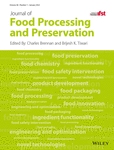Effects of thermally treated mulberry leaves on the quality, properties, and antioxidant activities of yogurt
Abstract
Mulberry leaf extract (MLE) was used to enhance the functionality of yogurt. Yogurt was fermented with 15% MLE prepared using different thermal treatment methods: no treatment (MY), steamed (SMY), and roasted (RMY). The controls were yogurt with no MLE (Y) and green tea extract (GY). Yogurt acidity was not significantly different among the samples after 8 hr of fermentation. Lactobacilli count was higher in MLE yogurts, with the thermal treatment method not impacting the count. MLE yogurts had high total anthocyanin, phenolic, and flavonoid contents and increased DPPH scavenging capacity. RMY showed the highest α-glucosidase inhibitory activity. MY had higher scores for MLE flavor, sourness, and astringency than Y. However, RMY had improved scores for sourness and astringency and high scores for sweetness and overall acceptability, which were higher than that of GY. Roasted mulberry leaf extract therefore has potential as a health supplement for food.
Practical applications
Mulberry leaves have been used as silkworm feed and in traditional medicine in Asia because of their high nutrient content and functional properties. However, the use of mulberry leaves as a food additive has been limited due to their unique aroma and bitter taste. To evaluate the potential application of mulberry leaf extract as a supplement in yogurt, thermal treatments of mulberry leavers were performed prior to extraction. Steamed and roasted mulberry leaves had a reduced off-flavor and less of a bitter taste, and improved the functionality of yogurt, namely, antioxidant capacity and α-glucosidase inhibitory activity. In particular, roasted mulberry leaf extract had higher functionality and better sensory score than green tea extract, which is used as an additive in commercial products, making it a better supplement for fortified yogurt products.
CONFLICT OF INTEREST
The authors have declared no conflicts of interest for this article.
Open Research
DATA AVAILABILITY STATEMENT
The authors confirm that the data supporting the findings of this study are available within the article. Raw data were generated in a laboratory at Korea University. The data supporting the findings of this study are available from the corresponding author upon request.




